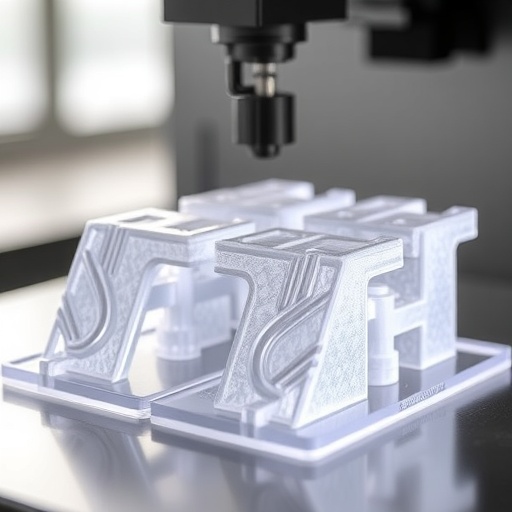In a groundbreaking advance within the realm of additive manufacturing, a recent study delves into an often-overlooked factor influencing fused filament fabrication (FFF)—the role of nonuniform forced convection. As 3D printing technology continues to revolutionize industrial production and rapid prototyping, the subtleties of environmental and thermal dynamics surrounding the printing process have garnered renewed scientific attention. This investigation reveals that varying airflow conditions around the polymer deposition site critically modulate local polymer properties and geometric precision, opening new avenues for enhancing the accuracy and mechanical performance of 3D printed parts.
Fused filament fabrication, a dominant technique in polymer 3D printing, operates by successively extruding molten filament, typically thermoplastics, layer by layer, to build intricate geometries. Despite its widespread adoption, issues like warping, dimensional inaccuracies, and unpredictable mechanical strength persist, often traced back to thermal gradients and cooling rates. The research team led by Keim, Young, and Hanson rigorously analyzed how forced air convection—an external factor routinely present in both industrial and desktop environments—impacts thermal dissipation and polymer solidification pathways during printing.
Through carefully controlled experimental setups and computational fluid dynamics simulations, the study unveiled that nonuniform airflow around the extruder nozzle creates spatially varying cooling rates. These differences, in turn, govern the crystallization kinetics and molecular orientation within printed layers. The localized polymer morphology directly affects adhesion between layers and the resulting microstructure, which are critical determinants for overall build quality and durability. Notably, areas exposed to stronger forced convection exhibited more rapid solidification, which increased residual stresses and led to compromised geometric fidelity.
This research importantly challenges the conventional assumption that thermal gradients are primarily dictated by the heated extrusion process alone. Instead, it emphasizes that even subtle variations in ambient air velocity and direction at the printing interface can dramatically alter the local heat transfer characteristics. The team quantitatively mapped temperature fields and flow velocities, correlating these parameters with morphological changes detected via microscopy and mechanical testing. Their integrative approach provides a comprehensive understanding of how airflow heterogeneity can induce dimensional deviations and anisotropic mechanical behavior.
One of the transformative insights from the study is the realization that controlling forced convection could serve as an untapped process parameter for fine-tuning polymer properties post-deposition. By tailoring localized cooling through programmable airflow patterns or strategic enclosure designs, manufacturers can potentially optimize layer bonding and reduce defects. This paradigm shift from passive environment considerations to actively engineered airflow conditions heralds a new frontier in FFF technology refinement.
Furthermore, the findings have immediate implications for scaling up 3D printing operations. Industrial printers, often operating in large open environments with complex ventilation dynamics, are particularly susceptible to nonuniform forced convection effects. This insight calls for revisiting facility design and integrating airflow management as a critical component of process control protocols. For desktop users and educational settings, recommendations now emerge emphasizing enclosure use and controlled ambient conditions to enhance print consistency.
Beyond geometric accuracy, the study reveals that mechanical properties such as tensile strength and elongation at break exhibit spatial variability linked to airflow patterns during fabrication. These functional property gradients can compromise structural integrity, especially in load-bearing applications. The interplay between forced convection and polymer crystallization hence provides a mechanistic explanation for previous observations of inconsistent performance in printed parts sharing identical processing parameters.
The research also illuminates the complexity of multiphysics interactions in additive manufacturing. It highlights how thermal, fluid dynamic, and material science domains converge within the confined space of the printing nozzle and build chamber. Their multidisciplinary approach, combining experimental diagnostics, advanced simulation techniques, and polymer science, sets a new standard for future studies aiming to optimize printing processes holistically.
From a practical standpoint, the work encourages the development of new sensor technologies capable of real-time monitoring of airflow and temperature distributions during printing. Integration of such feedback mechanisms would enable closed-loop control systems to dynamically adjust airflow or extruder parameters, mitigating adverse convection effects and enhancing part quality. Additionally, software tools predicting forced convection impacts could become invaluable in print preparation procedures.
Importantly, this study reaffirms the critical role of environmental factors that have historically been considered extrinsic or secondary in additive manufacturing workflows. It advocates for a more systemic perspective where printer design, build environment, and process parameters are optimized collectively rather than in isolation. Through this lens, improving additive manufacturing reliability becomes a matter of harmonizing multiple interdependent variables, facilitating wider adoption and industrial scalability.
In conclusion, the investigation into nonuniform forced convection’s influence on local polymer properties and geometric fidelity addresses a key bottleneck limiting fused filament fabrication’s full potential. By uncovering the mechanisms through which airflow patterns modulate cooling rates and subsequent polymer microstructures, this research paves the way for enhanced control over 3D printed part quality. Manufacturers embracing these insights could achieve unprecedented precision and mechanical reliability, advancing both prototyping and end-use applications.
The ripple effects of these findings extend beyond current material sets and printing configurations, hinting at strategies to optimize emerging polymer composites and multi-material FFF processes under complex thermal-fluid conditions. As additive manufacturing evolves, embracing the nuanced interplay of forced convection and polymer behavior will likely become a cornerstone of process innovation, setting new benchmarks for performance and consistency.
Looking forward, further exploration is needed to quantify the influence of specific airflow geometries, velocities, and thermal backgrounds on a wider range of polymer formulations. Combining these insights with machine learning models could accelerate the development of adaptive printing environments tailored to unique material and design demands. The study by Keim and colleagues thus stands as a seminal contribution, highlighting the imperative to integrate environmental convection control into the advancing landscape of additive manufacturing technology.
Subject of Research: Investigating the influence of nonuniform forced convection on polymer microstructural properties and geometric precision in fused filament fabrication.
Article Title: Investigating the effect of nonuniform forced convection on local polymer properties and geometric fidelity in fused filament fabrication.
Article References:
Keim, A., Young, J., Hanson, C. et al. Investigating the effect of nonuniform forced convection on local polymer properties and geometric fidelity in fused filament fabrication. npj Adv. Manuf. 2, 46 (2025). https://doi.org/10.1038/s44334-025-00056-7
Image Credits: AI Generated
DOI: https://doi.org/10.1038/s44334-025-00056-7
Tags: 3D printing polymer qualityairflow impact on polymer propertiescomputational fluid dynamics in manufacturingcontrolling cooling rates in 3D printingdimensional accuracy in 3D printingenhancing 3D printing techniquesenvironmental factors in polymer depositionfused filament fabrication challengesmechanical performance of 3D printed partsnonuniform cooling effects in 3D printingthermal dynamics in additive manufacturingthermal gradients in fused filament fabrication






